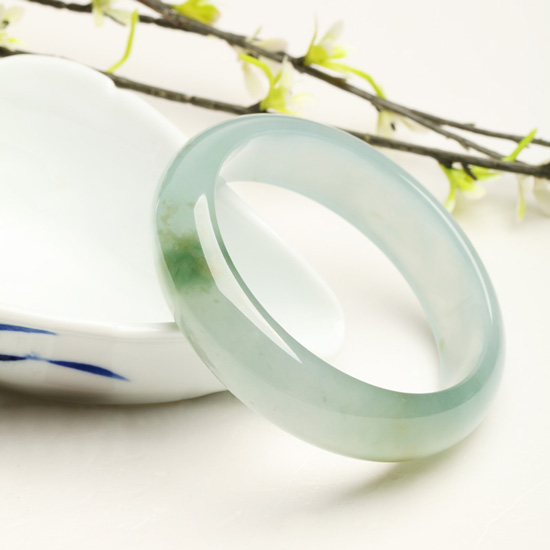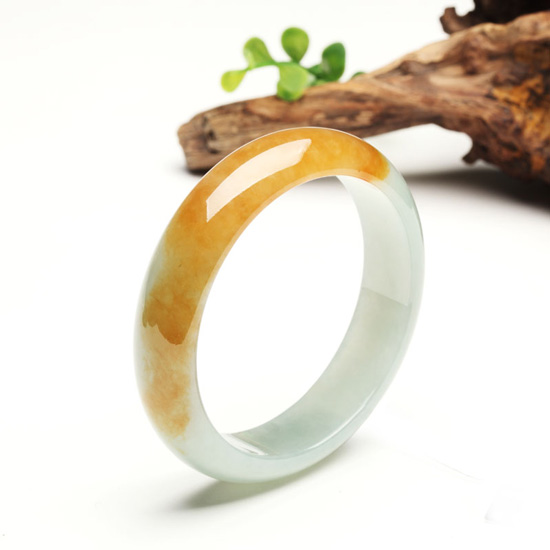Burmese jade has the reputation of the king of jade, is glass luster, bright and transparent, hardness 6.5-7 degrees, is a kind of green jade.

Jade has been a special commodity for exorcism and security since ancient times. She is rare and precious, not only makes the wearer show her respect, but also exudes a charming millennium jade culture.
Under normal circumstances, a piece of jade is rarely green, except for the "Cui" part, the other color is called "ground", the color of "ground" is white, yellow, black, blue, purple, lake green. The more the emeralds in the jade of Myanmar, the better.
High-quality jadeite should have "a good green, good water, good ground, and perfect perfection", that is, people often say "plant, water, color, work, perfection." Merchant pricing is also determined from these five aspects.
Of course, if all the above points are good, the price of this jadeite can be described as priceless. Gold has a price, and good jade is priceless. Of course, natural Burmese jade is not absolutely perfect, with more or less so-called cockroaches. What is the jadeite? What is the impact of ç‘•ç–µ on the value of jadeite?
According to the visual sense, jadeite products may have these phenomena: cracks, cracks, ribs, stone, stone, variegated, dirty, green and so on. The details are as follows:
Crack: The original stone is dropped during the handling process, and the sheet material is impacted during the processing, and the finished product is accidentally broken on the ground. Cracks are usually caused by the day after tomorrow (secondary). The outer cracks are mostly horizontal, visible to the naked eye, without fillers in the middle, nails can be scraped, some are very serious, some are very slight. (man-made)
Crack: The breakage of jade in the formation of long-term complex geological environment due to the action of external stress. The sputum is generally congenital (native), with many internal longitudinal lines, visible to the naked eye, with colored (impurity) fillers in the middle, nails are generally not scratchable, and there are serious and slight. (contributed by congenital formation, also known as natural crack)
Miscellaneous tendons: In the presence of the earth, it feels like a tree root and a slag-like variegated matter, which is an impurity that jade is mixed in during the formation of a long-term complex geological environment. The ribs are congenital (native), visible to the naked eye, not cracks, severe and slight.
Stone pattern: The local dislocation of jade in the formation of long-term complex geological environment due to external force extrusion. Its remarkable feature is that the adjacent parts of the jadeite are not uniform in structure and look like cracks. The stone pattern is congenital (native), visible to the naked eye, not a crack. There is generally no colored (impurity) filler in the middle. There are obvious and hidden, and the common ice pattern is one of the stone patterns.

Stone flower: The jadeite often has a slightly less transparent transparency than the ground. It is called a "stone brain" in the form of a dry block. It is called a "reed flower" in a loose shape. It is called "cotton" in the form of a cotton wool. It is called "snowflake".
Motley: Emerald has many colors, and there are large and small colors. Small areas or dots of green, red, and yellow, their presence can make the entire jade jewelry more beautiful and more characteristic.
It is called pretty color; small area or point-like black, brown, gray, etc., their presence can make the whole jade jewelry more ugly lower, called variegated; point-like black, brown, gray, etc. are also called dirty spots.
Cui nature: Jadeite is a multi-crystal intertwined structure. The crystal face will see a flake-like flash under the illumination of light. It is called “flying wings†or “shaxing†in the line. This is an important feature of jade.
The jadeite with thick structure (such as bean species) is more obvious, and the emerald structure (such as glass) with fine structure is not obvious. Different people have different understandings of jealousy. Some people think that cracks are considered paralyzed. Some people think that variegated stone flowers are also awkward. Some people think that sex (shaxing) is considered paralyzed.
In the jade industry, it is basically recognized that cracks and cracks are counted. The more pertinent point of view is that cracks and cracks must be counted; Cui Xing (Sha Xing) must not be awkward; if the degree of ribs, stone, stone, variegated, dirty spots, etc. is deep enough to affect the aesthetics of the original, .
If the degree is shallow, there is no obvious influence on the aesthetics of the original. Note that the presence of cockroaches affects the value of jadeite. The order of influence is generally: cracks, cracks, ribs, stone, stone, variegated, dirty spots.
For example, a bracelet with severely obvious cracks is almost a waste product, and a bracelet with a slight stone variegation has a limited impact on value.
In addition, the degree of influence is also related to the severity of a certain kind of cockroach itself. For example, a bracelet of the same color, with a very ugly variegation and a slight crease, may have a crease value rather than a variegated color. It must be high.
Therefore, it is generally necessary to be clear when purchasing Burmese jade, to recognize that natural is not absolutely perfect, due to its special formation environment.
[Waterproof shoes" refers to all footwear that is completely impervious to water, regardless of environmental factors.
Waterproof Shoe,Waterproof Boots,Waterproof Sneakers,Waterproof Trainers
zhejiang leima shoes ind.co.,ltd , https://www.safetyshoeschina.com